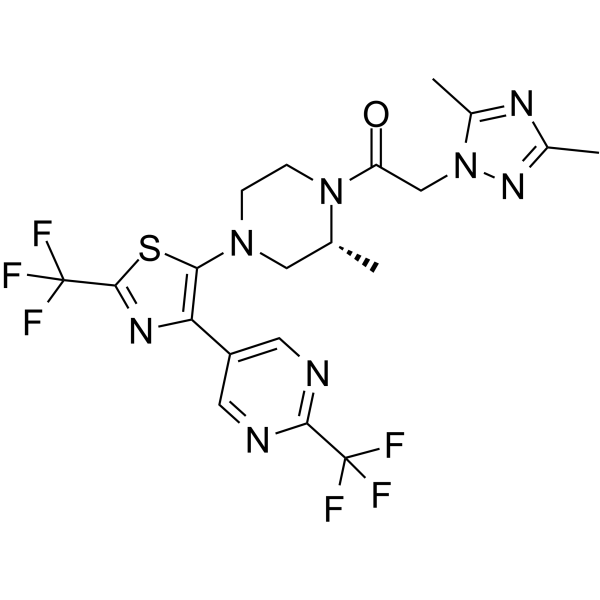1646267-59-5
| Name | ACT-660602 |
|---|
| Description | ACT-660602 is an orally active antagonist of chemokine receptor (CXCR3) with an IC50 value of 204 nM. ACT-660602 inhibits T-cell migration and shows efficacy in acute lung ingury model. ACT-660602 can be used for autoimmune diseases research[1][2]. |
|---|---|
| Related Catalog | |
| Target |
CXCR3:204 nM (IC50) |
| In Vitro | ACT-660602 shows selectivity to CXCR3 over hERG, with IC50s of 18 μM (hERG)[1]. ACT-660602 (112 nM; 6 h) inhibits cell migration and improves the metabolic stability[1]. ACT-660602 (5, 20, 100 or 500 nM) displays an non-competitive binding mode to CXCL10 and CXCL11 in different concentration, with more stable IC50s[1]. Cell Migration Assay [1] Cell Line: CD3/CD28-activated primary human T cells Concentration: 112 nM Incubation Time: 45 min Result: Inhibited cell migration. |
| In Vivo | ACT-660602 (1 μM; 6 h) intrinsic metabolic clearance (CLint) in human, rat, mouse liver microsomes (HLM, RLM, MLM)[1]. ACT-660602 (30 mg/kg; p.o.; once daily) displays anti-inflammatory activity and exerts efficacy in the mouse model of acute lung ingury[1]. Range for Pharmacokinetics of ACT-660602[1] Animal Route Dose (range) (mg/kg) Cmax (range) (ng/mL) Tmax (range) (h) AUC (range) (ng•h/mL) F (%) CL (range) (mL/min/kg) Vss (range) (L/kg) T1/2 (range) (h) Dog p.o. 2 1380 1 20000 8 1.3 1.7 14.5 i.v. 0.5 1300-1450 0.5-2.0 10400-32000 / 0.6-3.0 1.6-1.7 6.3- Rat p.o. 2 1520 0.5 14000 80 1.9 1.1 7.1 i.v. 0.5 1250-1860 0.5-1.0 11600-15641 / 1.9-1.9 0.9-1.3 5.7-8.8 Animal Model: LPS-induced lung inflammation model (72 h post LPS challenge)[1] Dosage: 30 mg/kg Administration: Oral gavage; once daily Result: Significantly reduced recruitment of the CXCR3+ CD8+ T cell in the bronchoalveolar lavage compartment. |
| References |
| Molecular Formula | C20H20F6N8OS |
|---|---|
| Molecular Weight | 534.48 |
